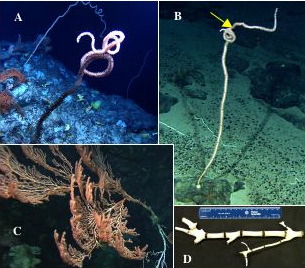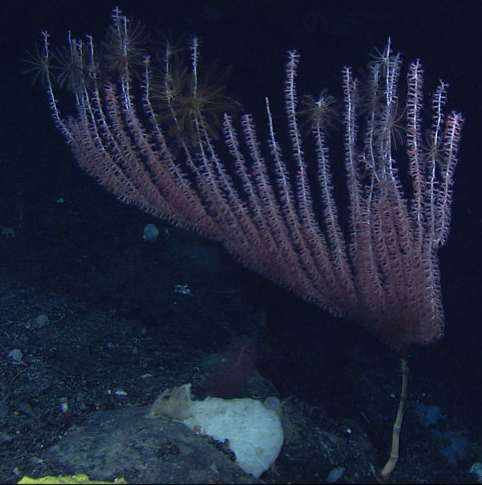Molecular Phylogeny of Deep-Sea Bamboo Corals (Keratoisidinae)
Bamboo corals (family Isididae) are among the most easily recognized deep-water octocorals due to their articulated skeleton comprised of non-sclerite calcareous internodes alternating with proteinaceous nodes. Most commonly encountered in the deep-sea are species in the subfamily Keratoisidinae. Systematists have long debated whether the genera Lepidisis and Keratoisis could be defined on the basis of “colony branching.” Although recent taxonomic keys use “colonies unbranched” to distinguish Lepidisis, the original description of the genus included both branched and unbranched morphologies, with both forms also classified in Keratoisis. We have analyzed mitochondrial DNA sequence variation from isidids collected between 500–2250 m depth to address the question: are unbranched, whip-like bamboo corals in the subfamily Keratoisidinae monophyletic? The results of an msh1 phylogeny suggests that the distinction between the genera Lepidisis and Keratoisis should not be based on whether or not colonies branch (France 2007). We continue to analyze additional genera, species and molecular markers to learn more about characters that may be used to distinguish evolutionary lineages within the subfamily Keratoisidinae; this work is being done in collaboration with Les Watling (U. Hawaii).


A candelabra-shaped bamboo coral at 1826 meters depth on Manning Seamount; comatulid crinoids (feather stars) can be seen on the tips of many branches. (Image copyright of the Mountains in the Sea Research Team; IFE; and NOAA)
Examples of bamboo corals in the subfamily Keratoisidinae. (A) Unbranched whip-like colonies (“Lepidisis”) > 2 m in height, with characteristic spiraling, distal ends, on Manning Seamount; (B) distally-forked colony on Balanus Seamount, 1560 m depth; the branching point, indicated by the arrow, is > 1 m above bottom and is obscured by the coiled end of one branch pointing out of the plane of the page; (C) internodal-branching colony (“Keratoisis”) on Bear Seamount, 1478 m depth; (D) skeleton fragment from colony in 1C, showing dark proteinaceous nodes, white calcareous internodes, and internodal branching (ruler = 15 cm). (Photo credits for A, B, C: Mountains in the Sea research group–Institute for Exploration (IFE)–NOAA) Figure from France (2007).